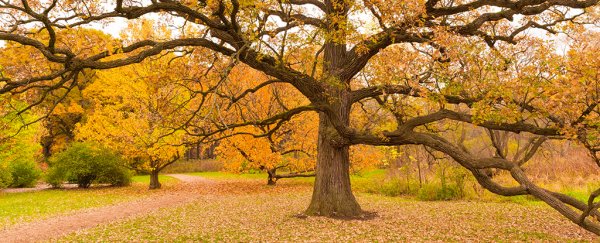The venerable elders of a forest are hugely important to the diversity, fitness, and survival of the woodland as a whole, new research shows – and they bring with them a hardiness and experience in dealing with change, as well as a lifetime of ecological interactions preserved in their immediate surrounds..
Scientists used models extrapolated from several previous studies to assess how many trees typically make it beyond the normal boundaries of tree old age, and to analyze the sorts of effects these ancient trees had on the rest of the flora around them.
A very small number of trees – less than 1 percent of a population – achieve ancient status, sometimes growing as many as 10 or 20 times longer than the average for the forest overall, the study shows.
These incredible outliers of the tree world can achieve such grand old ages among species that don't have set lifespans like us. Year after year, thanks to their genes, they weather whatever life throws at them, until one day their luck runs out.
Yet the longer these rare gems live, the greater the chance they might pass on these golden genes to a new generation.
"We examined the demographic patterns that emerge from old-growth forests over thousands of years, and a very small proportion of trees emerge as life-history 'lottery winners' that reach far higher ages that bridge environmental cycles that span centuries," says botanist Chuck Cannon from the Morton Arboretum in Illinois.
"In our models, these rare, ancient trees prove to be vital to a forest's long-term adaptive capacity, substantially broadening the temporal span of the population's overall genetic diversity."
In other words, these old-timers have seen it all – and that experience written into the tree genetics is something that rubs off on the rest of the forest and younger trees as new seeds are planted. In some cases, thousands of years of experience can be passed on.
Trees that have stood the test of time aren't just important because of their genetic and biological diversity, however. They also provide shelter for endangered species and are better at soaking up carbon than younger trees, the researchers found.
These old and ancient trees are now under severe threat though – not just through climate change, but through worldwide deforestation, meaning that trees of extraordinary age are becoming less common, with mortality rates for trees rising across all kinds of woodland.
"As the climate changes, it is likely that mortality rates in trees will increase, and it will become increasingly difficult for ancient trees to emerge in forests," says Cannon.
"Once you cut down old and ancient trees, we lose the genetic and physiological legacy that they contain forever, as well as the unique habitat for nature conservation."
Ancient trees, by their very nature, can't be quickly replaced. The only way to ensure we still have them is to protect mature trees as they continue to grow – and that means curbing the effects of climate change and deforestation.
The researchers liken the killing off of ancient trees as being similar to killing off animal species, in that once they're gone they're not coming back. Even trees that eventually grow to be as old won't have the same evolutionary history written into them.
As humans we have a long history of respecting and even revering ancient trees – and the authors behind this latest study say that we need to bring back some of that concern for the most elderly members of forests, to ensure their survival for the future.
"This study recalls the urgent need for a global strategy to conserve biodiversity, not only by preserving intact forests, but in particular the small remnant of a few ancient trees that have survived in managed forest landscapes," says ecologist Gianluca Piovesan from Tuscia University in Italy.
The research has been published in Nature Plants.
